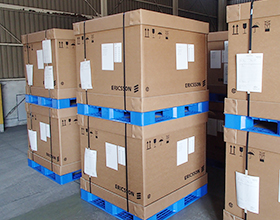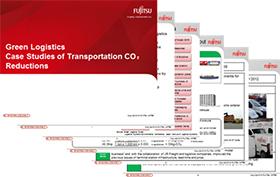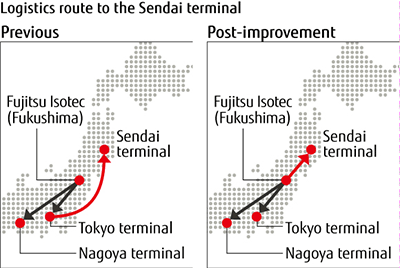Archived content
NOTE: this is an archived page and the content is likely to be out of date.
Case Studies
The Fujitsu Group carries out various activities through cooperation with logistics business operators and help from its customers. The activities include modal shift, reduction of the number of trucks used, shortening of transport distance, improvement of container loading efficiency, and reduction of the use of air transport.
Promotion of Modal Shift
We promote effective use of railroads and shifting from air transport to land transport for transportation of our products.
Promoting Modal shifts Utilizing Ferries (Fujitsu Ten Limited, Hyogo prefecture)
Fujitsu Ten Limited implemented a modal shift by switching from air to ferry shipments of car navigation systems between our Chinese plant and Japan. Not only do ferries have lower environmental burdens than shipments by air, they also offer lower costs and have shorter lead time compared to using ocean containers, for better transportation in terms of both economics and the environment.
Promoting Modal Shifts Overseas
In Fujitsu Technology Solutions GmbH (Germany), we have been undertaking a long-term initiative to boost logistics efficiency. The primary effort is to implement a modal shift from air to ocean transport for international shipments.
Reduction of Number of Trucks in Shipping Transportation
We are trying to reduce the number of trucks used through cooperation with logistics business operators and help from our customers.
Promoting Joint Transportation with Other Companies (Fujitsu)
Fujitsu is promoting joint transportation by combining Fujitsu cargo with the cargo of other companies. This collaboration applies both to shipments between logistics terminals and shipments from logistics terminals to customers, and has reduced the number of trucks used.
Improving Truck Loading Efficiency by Adjusting Delivery Dates (Fujitsu)
Collaboration and arrangements among Fujitsu's relevant divisions have made it possible to adjust the delivery dates of mobile phones, allowing us to reduce the number of trucks used for shipments.
Reducing Truck Transportation by Consolidating Factories
In FY 2014, we unified our domestic mobile phone factory at one location, Fujitsu Peripherals Limited (Hyogo Prefecture). This consolidation allowed us to organize shipments to customers and reduce the number of trucks needed.
Reducing Truck Transport by Incorporating External Warehouses inside our Factory
In FY2014, we have been able to reduce the number of truck runs between Factories and warehouses by moving leased warehouses near our Fujitsu Oyama Factory (Tochigi Prefecture) inside the Factory itself.
Improving Truck Loading Efficiency by Optimizing Packing Boxes
 Packing boxes stackable in two tiers
Packing boxes stackable in two tiers
In Fujitsu Telecom Networks Limited (Tochigi Prefecture), we examined our truck loading efficiency data for shipments of network products overseas. The result was a shift to packing boxes that could be stacked in two tiers. This new approach boosted our truck loading efficiency ratio and allowed us to reduce the number of trucks we use.
Reducing Trucks Transport between Factories
In Fujitsu Frontech Limited (Niigata Prefecture), we examined our truck loading efficiency ratio for regular shipments of repaired products between our Niigata and Kumagaya Factories. Carrying out cargo adjustments allowed us to reduce the number of trucks on this route.
Other Activities regarding Transport
The Fujitsu Group has devised various transport methods including the introduction of low-emission vehicles, reduction of emergency deliveries, and consolidated packing.
Sharing the "Case Studies of Transportation CO2 Reductions" with domestic and overseas group companies
We created and distributed the "Case Studies of Transportation CO2 Reductions," which is a collection of activities that have been held by domestic and overseas group companies. This publication serves as guidance for group companies.

Reducing Shipping Distances by Redesigning Logistics Routes
We reassessed the logistics route of PC products between Fujitsu Isotec Limited (Fukushima Prefecture) and the Sendai terminal, which allowed us to shorten the shipping distance. Prior to the change, the route to the Sendai terminal, which handles shipping for the Tohoku region, passed through the Tokyo terminal, where other packages were load to our trucks. The new approach instead made this a direct route to the Sendai terminal with no stop in Tokyo.

